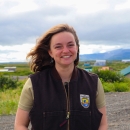Eelgrass (Zostera marina) is one of the predominant seagrass species found in Southwest Alaska and provides a vast range of ecosystem services for coastal habitats. Izembek Lagoon, at the center of Izembek National Wildlife Refuge, and a part of the Izembek State Game Refuge, is home to some of the largest eelgrass beds in the world, at approximately 17,000 hectares (65 square miles). These seagrass meadows provide spawning grounds for Pacific herring (Clupea pallasii), nursery areas for northern sea otters (Enhydra lutris kenyoni) and harbor seals (Phoca vitulina), and offer forage for nearly the entire Pacific Flyway population of brant (Branta bernicla) that pass through in the fall, just to name a few. Eelgrass acts as a good health indicator for coastal ecosystems because of its connection to a wide diversity of species.
U.S. Geological Survey and Izembek Refuge staff began developing techniques for monitoring eelgrass abundance and health in Izembek Lagoon in 2007, and survey efforts have been conducted annually since. The monitoring strategy includes a three-tiered approach across multiple spatial and temporal scales that can evaluate the health and productivity of eelgrass beds.
Tier-1 monitoring is conducted every 5 years and utilizes remote sensing of satellite imagery to delineate the spatial extent of eelgrass beds in the lagoon.
Tier-2 monitoring is completed annually in July and August, using a point sampling system to evaluate changes in the abundance, density, depth and reproduction across the entire lagoon. Researchers don drysuits and snorkels, and dive in the lagoon to record water temperature, water salinity, water depth, percent cover of eelgrass and seaweeds, and determine the presence or absence of sponges, bivalves, sea stars, gastropods, and crustaceans.
Tier-3 monitoring is performed annually in spring and in summer, and uses line transects established at specific eelgrass beds and evaluates how eelgrass abundance is affected by environmental drivers, such as light, temperature, and salinity. At each point along the transect, percent eelgrass cover is estimated, and a sample of eelgrass shoots are measured for length and width. Sensors are also deployed near the transects that monitor water temperature, light intensity, and water depth, factors which will impact the growth and abundance of eelgrass. In the past, cameras have also been used during the winter to monitor ice cover of the lagoon, which also affects spring growth of eelgrass.



